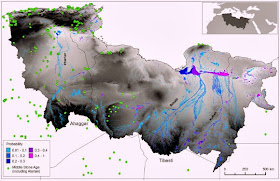Andre Willers
23 Oct 2013
Fertile Sahara .
When flowing, these
rivers – Irharhar, Sahabi and Kufrah – likely provided fertile habitats for
animals and vegetation, creating ‘green corridors’ across the region.
At least one river
system is estimated to have been 100 km wide and largely perennial.
The Irharhar river,
westernmost of the three identified, may represent a likely route of human
migration across the region.
In addition to rivers,
new simulations predict massive lagoons and wetlands in northeast Libya, some
of which span over 70,000-square kilometers.
“It’s exciting to think that 100,000 years ago there were three
huge rivers forcing their way across a 1,000 km of the Sahara desert to the
Mediterranean and that our ancestors could have walked alongside them,” said Dr
Tom Coulthard of the University of Hull, UK, who is a lead author of the study published in the journal PLoS
ONE.
Previous studies have
shown that people traveled across the Saharan mountains toward more fertile
Mediterranean regions, but when, where and how they did so is a subject of
debate.
Existing evidence
supports the possibilities of a single trans-Saharan migration, many migrations
along one route, or multiple migrations along several different routes.
The existence of ‘green
corridors’ that provided water and food resources were likely critical to these
events, but their location and the amount of water they carried is not known.
The simulations provided
in this study aim to quantify the probability that these routes may have been
viable for human migration across the region.
______
Bibliographic information:
Coulthard TJ et al. 2013. Were Rivers Flowing across the Sahara During the Last
Interglacial? Implications for Human Migration through Africa. PLoS ONE 8
(9): e74834; doi: 10.1371/journal.pone.0074834

No comments:
Post a Comment
Note: Only a member of this blog may post a comment.